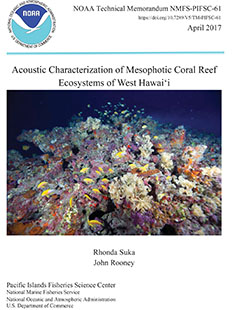-
Home
-
Data & Publications
-
Regional Portals
- About Regional Portals
- Florida
- Navassa Island
- Puerto Rico
- Flower Garden Banks
- U.S. Virgin Islands
- American Samoa
- Commonwealth of the Northern Mariana Islands
- Federated States of Micronesia
- Guam
- Main Hawaiian Islands
- Republic of the Marshall Islands
- Northwestern Hawaiian Islands
- Republic of Palau
- Pacific Remote Island Areas
-
CRCP Activities
- Glossary
NOAA Technical Memorandum NMFS-PIFSC-61 - Acoustic Characterization of Mesophotic Coral Reef Ecosystems of West Hawaii

Coral reef habitats in Hawaii are common in shallow waters and extend into mesophotic depths (30-150 m). However, habitat monitoring efforts have been concentrated in depths constrained by safe dive limits of 0-30 m. Mesophotic coral ecosystems (MCEs), located in depths of 30-150 m, are important components of the coral reef ecosystem, but only a small number of surveys have been conducted in these depths. Data for these deep-water habitats are essential for evaluating and monitoring their health and resilience. Classifying benthic habitats in mesophotic depths is challenging due to dive safety limits and water penetration capabilities of remote sensing options, such as satellite imagery and Light Detection and Ranging (LiDAR). The results of this effort show that acoustic data can be used to provide detailed substrate and biological cover maps that include mesophotic coral ecosystems. Here the authors employ a combination of principal component analyses and unsupervised classification techniques to derive six substrate and five biological cover classes from multi-beam acoustic data, which are validated by optical seafloor imagery to create a complete benthic habitat map for the West Hawaii Habitat Focus Area (WHHFA). The results of this study show that the overall accuracy of the benthic habitat maps is 59% for substrate classification and 61% for biological cover classification. Accuracy was higher for the following individual classes; 76% Complex Reef, 86% Sand, and 88% Coral. These habitat maps are the first within the WHHFA to incorporate mesophotic data and provide important information for evaluating and managing the coral reef ecosystem as a whole.
Acknowledgements: This technical memo was made possible with funding support from NOAA's Coral Reef Conservation Program and NOAA's Office of Habitat Conservation in support of NOAA's Habitat Blueprint Initiative. Numerous people helped at various stages of the project. Frank Parrish, Michael Parke, and Russell Watkins helped to get the initial funding. Data and feedback were provided by Tomoko Acoba, Tim Battista, Eric Conklin, Annette DesRochers, Jamison Gove, John Hansen, Brittany Huntington, Frances Lichowski, Robert O'Connor, Frank Parrish, Michael Parke, Jennifer Samson, Yuko Stender, Curt Storlazzi, Bernardo Vargas-Angel, Bill Walsh, Lani Watson, and Mariska Weijerman. Technical support and analysis were provided by Michael Akridge, Jade Austin, Gabriel Cohen, Bryan Costa, Allan Elegino, Carla Esquivel, Stuart Goldberg, and Liana Roberson. Field support was provided by Kelli Bliss, Carmen DeFazio, Hank Lynch, and Kristin Raja.
Citation: Suke, R. J. Rooney. 2017. Acoustic Characterization of Mesophotic Coral Reef Ecosystems of West Hawaii. U.S. Dep. Commer., NOAA Tech. Memo., NOAA-TM-NMFS-PIFSC-61, 31 p. https://doi.org/10.7289/V5/TM-PIFSC-61.
NOAA Technical Memorandum NMFS-PIFSC-61 - Acoustic Characterization of Mesophotic Coral Reef Ecosystems of West Hawaii: (full report, pdf 1.12 MB)
For more information, contact:


